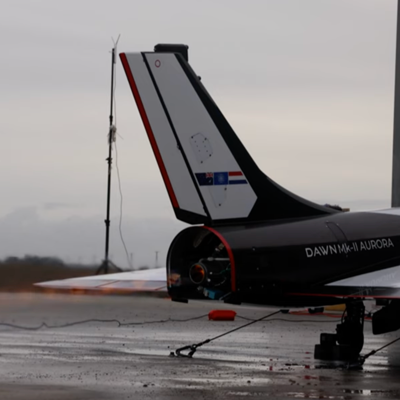
A still from an engine test for the Dawn Aerospace Mk-II Aurora Dawn Aerospace
The competition for new highly-maneuverable missiles just got much hotter.
Dawn Hypersonics — part of Dawn Aerospace — today revealed it has achieved supersonic flight with their prototype Mk-II Aurora craft off the coast of New Zealand. Defense One spoke exclusively with the company’s co-founder and CTO, Stefan Powell, on what the success means for the U.S. missile race.
On November 7, the Mk-II Aurora completed a 66,000 foot ascent in just 118.6 seconds, beating the previous decades-old record by more than 4 seconds. “With flight test 57, we retired the final major technical risk; vehicle dynamics through the transonic regime [between Mach 0.8 to 1.2]. In doing so, Aurora became the highest climb rate aircraft ever built. The door is now wide open for Aurora to become the world’s highest and fastest flying aircraft too,” Powell said.
The U.S. military is racing to deploy a wide variety of high-speed, highly maneuverable missiles capable of hypersonic speeds, Mach 5 and above. But reaching supersonic speeds while maintaining maneuverability and control is a bigger barrier, said Powell. Once you overcome that obstacle, the transition from supersonic to near hypersonic speed is much easier. Powell said that the ultimate goal is to get the Aurora up to about Mach 3.5, or about 2,685 miles per hour.
That’s a bit beneath the technical definition of hypersonic. But the military’s goal in its highly-maneuverable missile program isn’t a magic number, it’s a missile that can beat the world’s most advanced air defense systems. After all, intercontinental ballistic missiles from the 1960s hit speeds above Mach 5 by flying in a simple ballistic path through space, which is also why they are beatable. High maneuverability means flying much closer to the Earth, at near space altitudes of between 20 and 100 kilometers. At those heights, atmospheric and other forces put a lot of pressure on aircraft moving at extremely high speeds. And maneuvering becomes an even greater challenge.
The Mk-II builds off jet aircraft design and is intended to be reusable, up to two flights a day, but doesn’t require a pilot, essentially making it a highly-maneuverable missile if that’s how the operator chooses to use, or a high-altitude surveillance drone that’s much harder to hit than many of those currently in use.
“We really want it to act like a jet engine, but you want to have the thrust-to-weight ratio of a rocket engine, which is about 20 times better than a jet and that means you don’t end up building the whole aircraft around the engine. Most of the aircraft is actually just propellant and you got a tiny little engine at the back that really just kicks ass and gets you up to these hypersonic speeds,” Powell said.
The decision to make a jet that can serve as a missile, rather than focus on some minimal innovation on hypersonic engine design, was key to getting the craft certified as an aircraft and that made a huge difference in getting the necessary certifications to do testing, said Powell. “Avoiding such novelty saves us literal decades of development and is why we already have a well-developed flight test program with 50+ flights under our belt,” he said.
That flight test record is the company’s real advantage. Powell admits that while the Mk-II boasts an innovative design, it was a series of business decisions that enabled rapid and repeated testing. It’s a big part of the reason the company is based in New Zealand.
“This is the real secret source of Dawn Aerospace testing. A lot of very forward-leaning companies come to New Zealand to do the aerospace testing, Powell said. “Merlin Labs is one. Wisk [Aero] is another, because the CAA, our equivalent to the FAA, is extremely forward thinking. A small enough organization that you can get them all around a single table and talk to them and figure out this stuff of like, how are we going to do this in a constructive way? And they have a few rule sets that are performance-based rather than prescriptive, which means they require you to uphold a certain level of safety, rather than tell you how to design the vehicle.”
That allows the company to conduct tests out of a commercial airport. Contrast that with the severe limitations on test range facilities that are hobbling hypersonic missile development in the United States.
While the company is aiming for the military market, Powell sees an expanded future for hypersonic craft in the commercial and public sector as well.
“I think what we’re seeing now and what we will experience over the next 15 to 20 years will be very similar to the story of the jet engine, where the first markets were absolutely military, but potentially, in the long run, the most interesting applications are actually in the commercial sphere,” Powell said.

